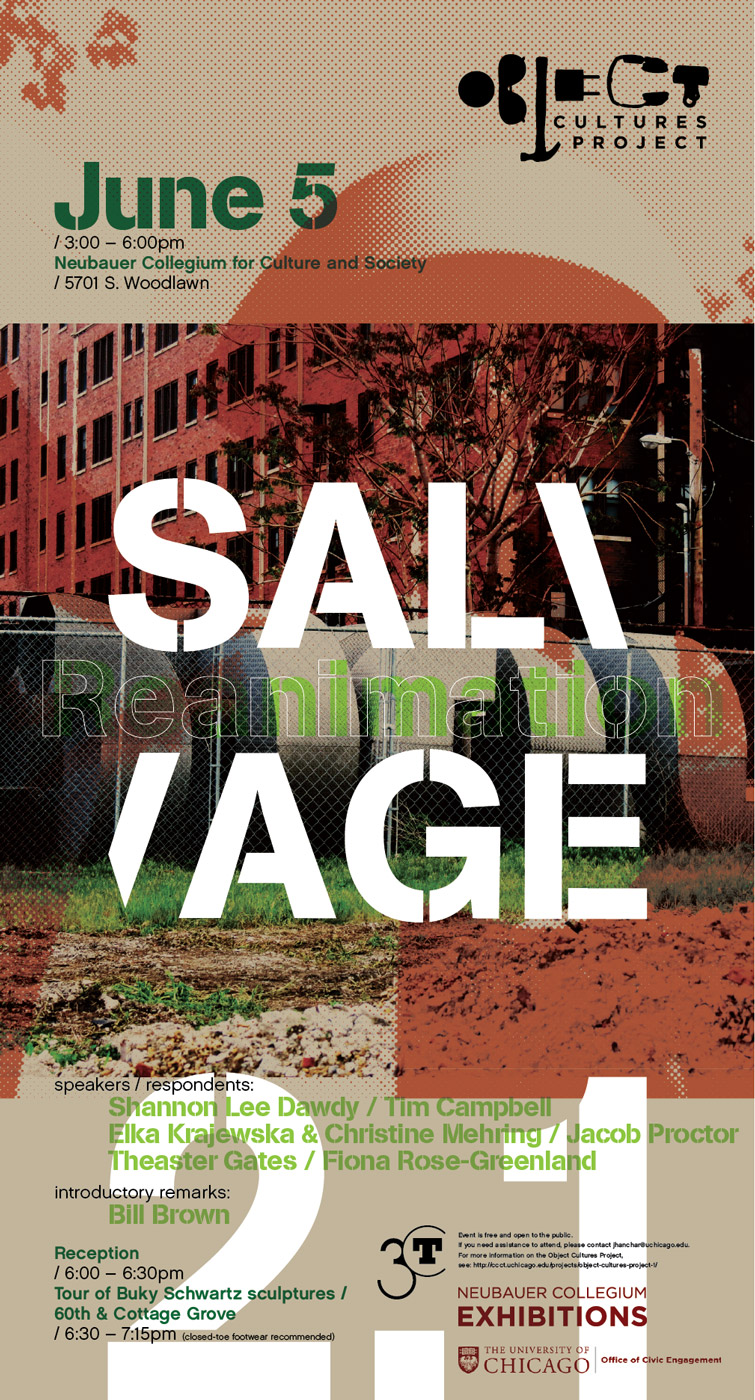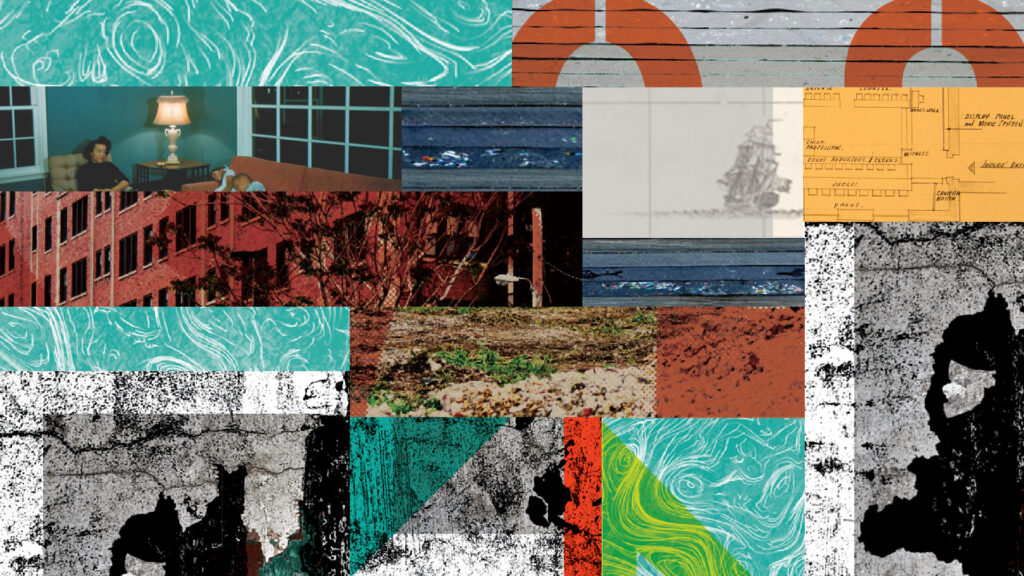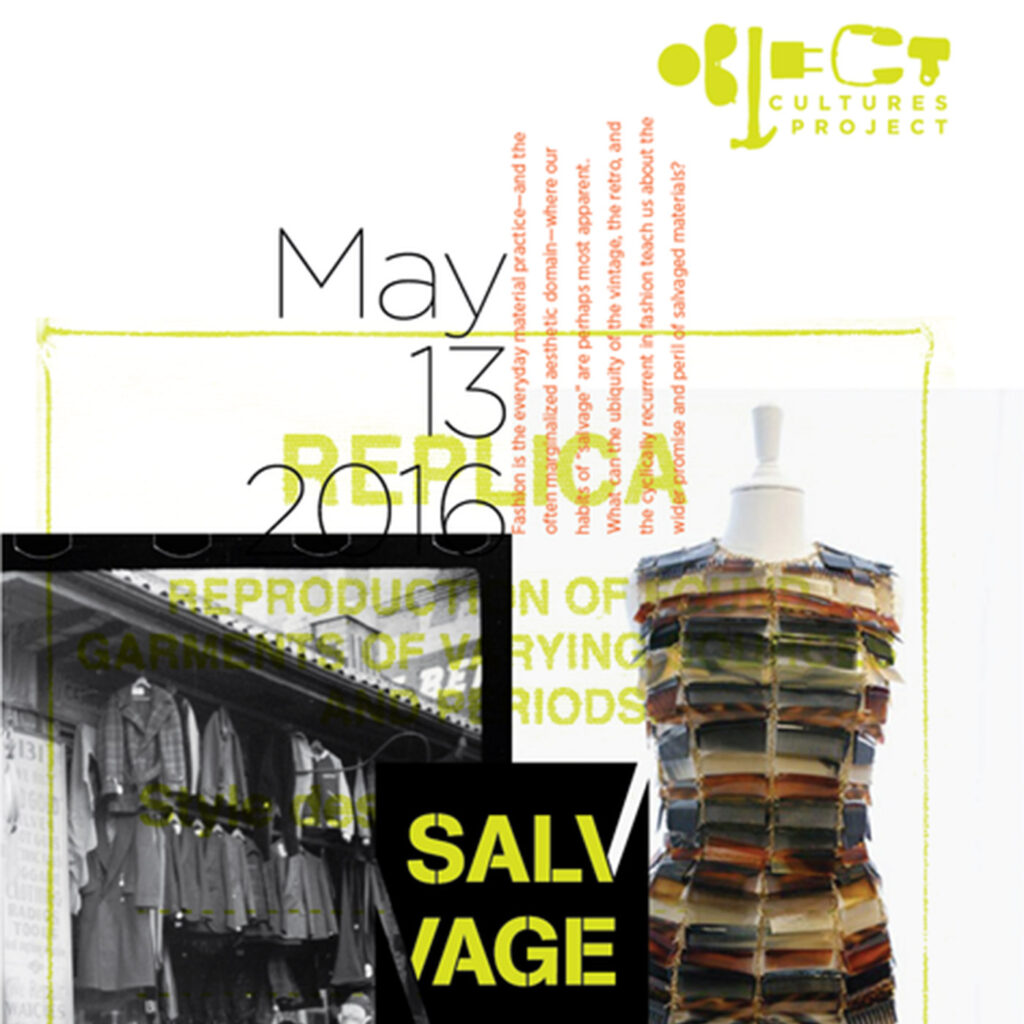Please join us as we continue to explore the theme of salvage. We launched our exploration with the 2014 conference Salvage 1.0: A Conference/Conversation/Caucus on Behalf of the Act and the Art of Salvage, which addressed issues of use value (namely, what happens to art that is damaged and loses its aesthetic, financial or social value). We continued the conversation in April 2015 with Salvage 2.0: Meanings/Material/Value, a panel centered on how shifts in materiality affect and disrupt the value and significance of various artistic practices. Salvage 2.1: Reanimation is the next iteration of this ongoing discussion.
The theme for this event marks our interest in how restoring or reviving obsolete materials or objects affects our understanding of their life spans and display value. As we have previously explored, the act of salvaging can be considered an act of disobedience, an effort to disrupt the “laws” of obsolescence, disposability, and decay. How might reanimation resist these presumably inevitable conditions, and how do new historical, temporal, and socio-political contexts shift the meanings available to the original work? If things have an uncanny tendency to come to life, what are the results of specific interventions to reanimate once-living things that were pronounced inert, useless, or valueless?
3:00pm — Opening remarks, Bill Brown
3:15pm — Shannon Lee Dawdy
3:40pm — Panel with Tim Campbell
3:50pm — Q&A
4:05pm — Elka Krajewska & Christine Mehring
4:30pm — Panel conversation with respondent Jacob Proctor
4:40pm — Audience Q&A
5:05pm — Theaster Gates
5:30pm — Conversation with Fiona Rose-Greenland
5:40pm — Q&A
5:55pm — Joint Panel, Concluding Remarks
6:10pm — Reception
6:45pm — On-site tour of Buky Schwartz’s Untitled Sculpture
Tim Campbell, English
Tim Campbell (Ph.D Indiana) studies intersections between the historical of the novel and fashion. Campbell’s recent publications include a forthcoming book, Historical Style, and “Fashion, Microcosm, and Romantic Historical Distance,” in Rethinking Historical Distance: Varieties of Historical Engagement (Palgrave, 2013).
Shannon Lee Dawdy, Anthropology
(PhD, U Michigan 2003) 2010 MacArthur Fellow and Associate Professor of Anthropology and of Social Sciences in the College, Dawdy is an anthropologist whose fieldwork combines archaeological, archival, and ethnographic methods with a regional focus on the U.S. South, the Caribbean, and Mexico (especially Louisiana, Cuba, and eastern Mexico). Her first single-author book, Building the Devil’s Empire, offers ‘rogue colonialism’ to explain how French New Orleans, and many colonies like it, functioned outside state controls, developing a political economy loosely moored to metropolitan interests. Her most recent book, Patina: A Profane Archaeology of the Antique (University of Chicago Press, 2014), examines the intimate relations between people and old things like antiques, heirlooms, historic houses, and ruins, based on the archaeology of New Orleans and ethnographic interviews with Katrina survivors. Other recent publications include a piece co-authored with Alexandra Hartnett called “The Archaeology of Illegal and Illicit Economies” (Annual Review of Anthropology, 2013) and “Why Pirates Are Back.” (Annual Review of Law and Social Science, 2011).
Theaster Gates, Visual Arts
Gates (MFA, ISU) has a ranging practice that includes space development, object making, performance, and critical engagement with different publics. Gates founded the Rebuild Foundation, is currently a Professor in the Department of Visual Art and Director of Arts and Public Life at the University of Chicago, and has has exhibited and performed at a variety of venues from the Studio Museum in Harlem, New York to Documenta 13 in Kassel, Germany. Recent winner of Artes Mundi 6, Gates has also received awards and grants from Creative Time, the Vera List Center for Art and Politics, United States Artists, Creative Capital, the Joyce Foundation, Graham Foundation, Bemis Center for Contemporary Arts, and Artadia.
Elka Krajewska, Salvage Art Institute
Krajewska (MFA Yale) was born in Warsaw and based in New York City, and is the president and founder of Salvage Art Institute as well as an artist who works with film, sculpture, music and mixed media. Krajewska’s work utilizes elements of her biography, contemporary interdisciplinary art historical strategies and is often based on collaboration. Her most recent installation is a “performative object” titled “Charlotte Madeline” (2014) that comes to life when users manipulate the objects parts to produce soundscapes. Krajewska’s “No Longer Art” is currently on display at the Neubauer Collegium.
Christine Mehring, Art History
Mehring (Ph.D. Harvard) is the Department Chair and Professor of Art History and the College at the University of Chicago. Research interests include abstraction, art and design, postwar Western Europe, German art, relations between new and traditional media. Recent publications include “Shock Value: Sigmar Polke” (Artforum, April 2014) and “Richter’s Willkür” (Art Journal, Winter 2012). Mehring is currently working on reviving University-owned artistic installations in collaboration with Elka Krajewska.
Jacob Proctor, Art History
Proctor (MA Harvard) Curator of the Neubauer Collegium for Culture and Society and Lecturer in the Division of Humanities, Proctor offers courses in contemporary art and criticism through the MA Program in the Humanities and the Departments of Art History and Visual Arts. Recent publications include the forthcoming Morgan Fisher: Conversations (Aspen: Aspen Art Museum) and Simon Denny: Full Participation (Aspen: Aspen Art Museum, 2012).
Fiona Rose-Greenland, Art History
Rose-Greenland (Ph.D Oxford, Ph.D Michigan) is the Associate Research Director at the Neubauer Collegium. Recent publications include “Looters, Collectors, and a Passion for Antiquities at the Margins of Italian Society” in the forthcoming Journal of Modern Italian Studies and “Seeing the Unseen: Prospective Loading and Knowledge Forms in Archaeological Discover” in Qualitative Sociology 36(3): 251-277.





